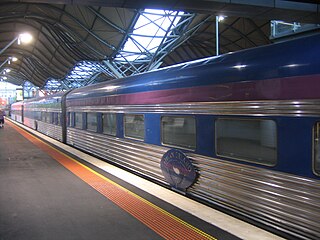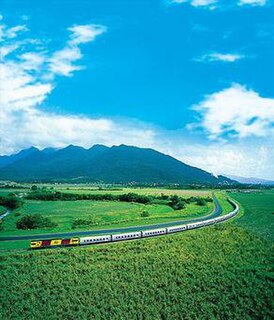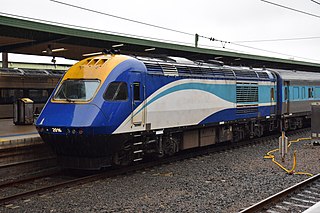Related Research Articles

The Indian Pacific is an Australian tourist passenger train that operates between Sydney, on the Pacific Ocean coast, and Perth, on the Indian Ocean coast. It is one of the few truly transcontinental trains in the world. It first ran in February 1970 after the completion of gauge conversion projects in South Australia and Western Australia, enabling for the first time a cross-continental rail journey that did not have a break of gauge.

CountryLink was a passenger rail and road service brand that operated in regional areas New South Wales, Canberra, Brisbane and Melbourne. Originally created as a business unit of the State Rail Authority of New South Wales, it later became a subsidiary of RailCorp, a Government of New South Wales entity. CountryLink operated rail services using XPT and Xplorer rolling stock, with connecting coach services operated under contract by private operators.

The Overland is an Australian passenger train service between the state capitals of Melbourne and Adelaide, a distance of 828 km (515 mi). It first ran in 1887 as the Adelaide Express, known by South Australians as the Melbourne Express. It was given its current name in 1926. Now operated by private company Journey Beyond, the train undertakes two return trips a week. Originally an overnight train that stopped at large intermediate stations, it now operates during the day, stopping less frequently. The Overland was converted to standard gauge in the 1990s and now operates from Melbourne over the longer standard gauge line initially heading south to the port city of Geelong, before returning to its original route in Ararat. After departing Ararat the train stops in the Victorian towns of Stawell, Horsham, Dimboola and Nhill before crossing the South Australian border. The final stretch into Adelaide, after crossing the Murray River is over the scenic Adelaide Hills. The train contains Red Premium and Red seated accommodation and a bar/lounge car, Café 828.

The Westland was the name given in 1938 to the overnight train operated by the Western Australian Government Railways (WAGR) with sitting and sleeping cars between Perth and Kalgoorlie, where it connected with the Trans-Australian service to Adelaide.

Caledonian Sleeper is the collective name for overnight sleeper train services between London and Scotland, in the United Kingdom. It is one of only two currently operating sleeper services on the railway in the United Kingdom, the other being the Night Riviera which runs between London and Penzance.

The Sunlander was a long distance passenger rail service operated by Queensland Rail on the North Coast line between Brisbane and Cairns in Queensland between June 1953 and December 2014. It has been replaced by the Spirit of Queensland.

The Spirit of Progress was the premier express passenger train on the Victorian Railways in Australia, running from Melbourne to the New South Wales border at Albury, and later through to Sydney.

The New South Wales XPT is a class of diesel-powered passenger trains built by Comeng and ABB Transportation. Based on the British Rail designed Intercity 125 High Speed Train, each XPT set is made up of two locomotives coupled to between four and seven carriages. The first sets entered service under the State Rail Authority in 1982 and now operate under NSW TrainLink, running on long-distance regional and interstate North Coast, Main Western and Main Southern lines throughout New South Wales and interstate into Victoria and Queensland.

The Southern Aurora was an overnight express passenger train that operated between Australia's two largest cities, Sydney and Melbourne. First-class throughout, including the dining facilities, the Southern Aurora featured all-sleeper accommodation. The train first ran on 16 April 1962 after the opening of the North East standard gauge line from Melbourne to Albury, eliminating the break-of-gauge between the capital cities.

The S type carriages are a corridor-type passenger carriage used on the railways of Victoria, Australia. The first carriages were constructed by the Victorian Railways in 1937 for use on the Spirit of Progress, with additional carriages built for other trains until the mid-1950s.

The Inter-Capital Daylight was a passenger train that operated between Australia's two largest cities, Sydney and Melbourne from March 1956 until August 1991.
The Victorian Railways (VR) of Australia and successors have utilised a number of different types of railway carriages and wagons for the supply of head end power to passenger trains on the Victorian railway network.

A motorail train or accompanied car train (ACT) is a passenger train on which passengers can take their car or automobile along with them on their journey. Passengers are carried in normal passenger carriages or in sleeping carriages on longer journeys, while the cars are loaded into autoracks, car-carriers, or flatcars that normally form part of the same train.

The RUB type carriage stock was a type of steel bodied air conditioned passenger carriage operated by the New South Wales Government Railways from September 1949 until April 2000.
The New South Wales stainless steel carriage stock was a type of passenger carriage operated by the New South Wales Government Railways from 1961 until 1993.
This article is intended as a catalogue of sleeping carriages used by the Victorian Railways and successors.
The R type carriages were a series of locomotive-hauled carriages proposed to be built for the Victorian country rail network in the early and mid 1980s.
The Train of Knowledge was an Australian school camp on wheels, allowing students and teachers to visit multiple locations around Victoria without having to organise accommodation or transport.

The E type carriages were wooden express passenger carriage used on the railways of Victoria, Australia. Originally introduced by Victorian Railways Chairman of Commissioners Thomas James Tait for the interstate service between Melbourne, Sydney and Adelaide, these Canadian-inspired carriages remained in regular service for 85 years over the entire Victorian network.